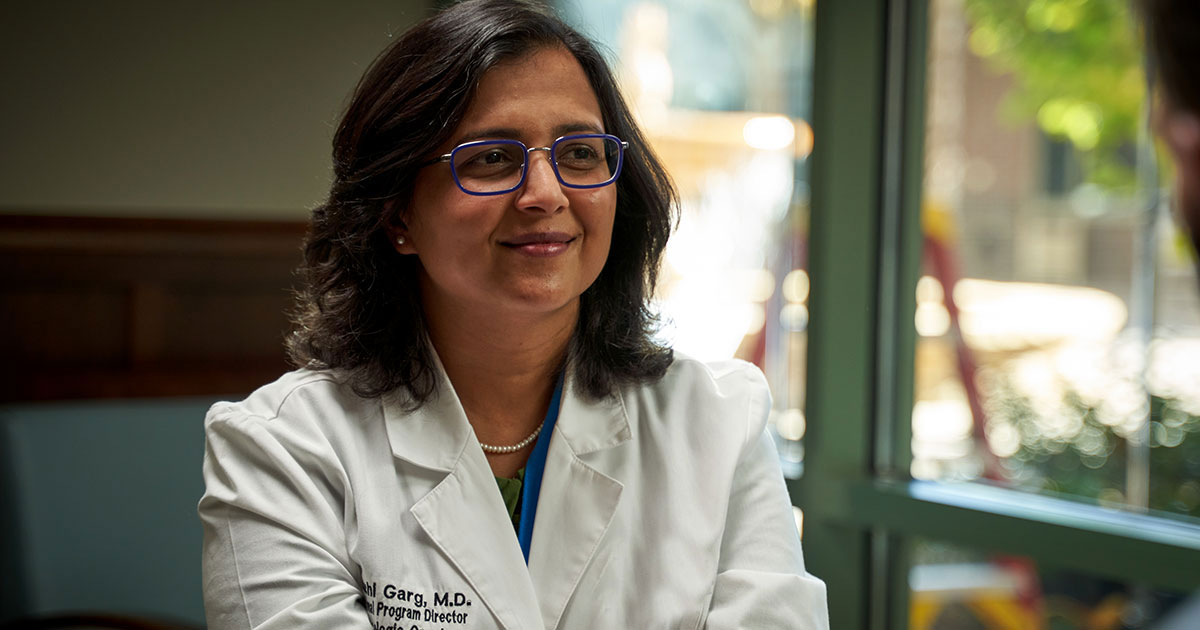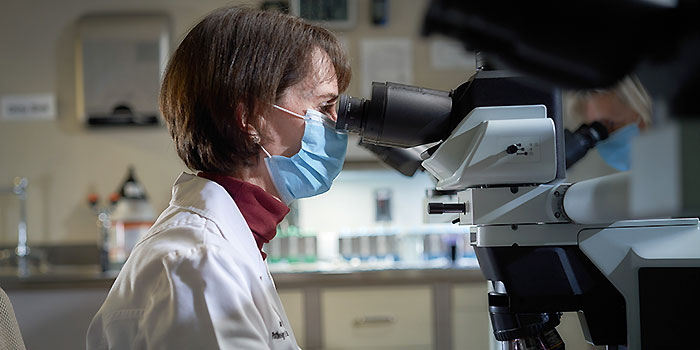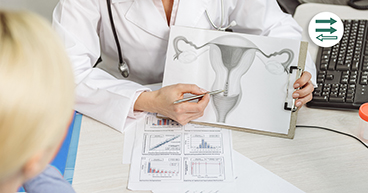
Like colorectal cancer, breast cancer and some other diseases, uterine cancer has increasingly become more common among young adults. Already the ninth-most common cancer diagnosed in the United States, the disease has seen a troublesome rise in the number of new cases in recent years. Why? Perhaps because of two main reasons, says Ruchi Garg, MD, Chair of Gynecologic Oncology at City of Hope Atlanta, Chicago and Phoenix:
- Many women with symptoms like vaginal bleeding may not have gone to their doctor in a timely manner during the COVID-19 pandemic.
- There is a disturbing trend in incidence rates among younger patients.
The average age of a woman diagnosed with uterine cancer—often referred to as endometrial cancer—is 63. Most patients are older than 50 and have gone through menopause. But in a presentation delivered in 2021 to the American Society of Clinical Oncology (ASCO), researchers noted that:
In women aged 20 to 29, cases of endometrial cancer increased from 0.6 per 100,000 in 2001 to 1.2 per 100,000 in 2017.
In women aged 30 to 39, cases increased from 4.6 per 100,000 in 2001 to 7.5 per 100,000 in 2017.
Other cancers rising in young adults include:
- Breast cancer
- Colorectal cancer
- Esophageal cancer
- Lung cancer
- Pancreatic cancer
- Prostate cancer
- Stomach cancer
“In younger women, it's mostly due to metabolic syndrome leading to higher BMI, and there could also be a genetics aspect that always needs to be evaluated,” Dr. Garg says. “In the last decade, I’ve seen a lot more younger women with endometrial pre-cancer or cancer than I've ever had previously.”
Women diagnosed with uterine cancer or those who may be at high risk may have questions about the disease and are likely to go to a search engine for answers. Studies show that before asking their doctor, nearly 90 percent of Americans go to Google to get answers to their medical questions.
In this article, we’ll answer some of your most frequently Googled uterine cancer questions, with the help of Dr. Garg. Questions include:
- What’s the difference between uterine cancer and endometrial cancer?
- What are the most common uterine cancer symptoms that patients experience?
- Is it easy for uterine cancer to spread?
- Is it possible to survive stage 4 uterine cancer?
- Does uterine cancer show up on a blood test?
- What causes uterine cancer?
- Is uterine cancer hereditary?
If you’ve been diagnosed with uterine cancer and are interested in a second opinion on your diagnosis and treatment plan, call us or chat online with a member of our team.
What’s the difference between uterine cancer and endometrial cancer?
“Uterine cancer is a global term we use because the uterus is the organ in which the cancer is found,” Dr. Garg says.
The endometrium, the inner lining of the uterus, is where about 95 percent of uterine cancers are detected. Endometrial cancer specifically refers to cancer that develops in the endometrium.
Other types of uterine cancer include:
- Leiomyosarcoma, which forms in the muscle of the uterus or other organs
- Uterine papillary serous carcinoma, an aggressive cancer that accounts for about 10 percent of the endometrial cancers
- Clear cell carcinoma, which may also be aggressive and is diagnosed in about 5 percent of cases
- Carcinosarcoma
- Uterine sarcoma
What are the most common uterine cancer symptoms that patients experience?
Women may experience a wide variety of signs or symptoms of uterine cancer, though some experience no symptoms at all.
“Most women have some spotting or abnormal bleeding,” Dr. Garg says. “Most diagnoses occur in postmenopausal women. So, any kind of spotting in somebody who's postmenopausal is considered abnormal and further tests need to be performed to either diagnose or rule out uterine cancer. Having said that, just to cut down on the fear, most of these patients do not have cancer but the patient still needs to be evaluated.”
Other signs and symptoms of uterine cancer include:
- Pelvic pain/cramps or pressure
- Abnormal vaginal discharge
- Pain during intercourse
- Weight loss
- Bowel or bladder changes
These symptoms may also be caused by conditions other than cancer, so it's important to get a proper diagnosis.
Is it easy for uterine cancer to spread?
Nearly 70 percent of uterine cancers are diagnosed when the disease is localized, or confined to the uterus. As with most cancers, uterine cancer has better outcomes when it’s diagnosed early. The five-year survival rate of patients diagnosed with localized uterine cancer is 95 percent.
Uterine cancer may spread to nearby tissue, including in the vagina, fallopian tubes, ovaries, rectum or bladder. The five-year survival rate for patients diagnosed with regional spread of uterine cancer is 70 percent.
Is it possible to survive stage 4 uterine cancer?
About 10 percent of uterine cancers are diagnosed when the disease has spread to distant organs at stage 4. In patients diagnosed with metastasized cancer, the five-year survival rate is about 18 percent.

Does uterine cancer show up on a blood test?
A Pap test is the only standardized test to screen for gynecologic cancer, but it’s only used to detect cervical cancer. There’s no screening test for uterine cancer.
A blood test may reveal high levels of a protein called cancer antigen 125 (CA-125) and may be “clinically useful” in helping to detect endometrial cancer, according to a paper published in the American Journal of Obstetrics & Gynecology.
But many non-cancerous conditions may also cause high CA-125 levels, including:
- Uterine fibroids
- Endometriosis
- Pregnancy
High levels of CA-125 may also be a sign of ovarian cancer, and CA-125 blood tests may help determine how ovarian cancers are responding to treatment.
What causes uterine cancer?
The exact cause of each uterine cancer diagnosis may never be known, but certain risk factors are strongly linked to the disease. The most common factors are explained below.
Menstrual history: Women who’ve had more menstrual cycles in their lifetime are at increased risk.
Obesity: Fatty tissue tends to produce higher levels of estrogen, particularly after menopause. As many as 70 percent of uterine cancer cases are thought to be linked to obesity, according to ASCO.
Other medical conditions: Previous breast cancer or ovarian cancer, diabetes and hypothyroidism also raise the risk.
Previous medical treatments: Radiation therapy for cancer in the pelvic area and hormone therapies, including treatment with the drug tamoxifen, may increase risk for certain uterine cancers.
Infertility: Irregular menstrual cycles and infertility may be associated with imbalances in hormone levels, which may increase the risk.
No pregnancies: “When you get pregnant, your ovaries are basically dormant,” Dr. Garg says. “So, you're not getting that constant hormone stimulation, the estrogen stimulation that may increase the risk of uterine cancer. When a woman doesn’t bear children, the ovaries are constantly producing estrogen, which therefore increases the exposure and risk for uterine cancer.”
Is uterine cancer hereditary?
Up to 10 percent of uterine cancers are linked to hereditary factors. Family history of cancer doesn’t mean you’ll develop cancer, but it may mean you’re at higher risk.
Having the hereditary cancer condition known as Lynch syndrome, for example, may increase risk. Lynch syndrome results from mutations in any of several genes that allow damaged DNA to repair itself. When one of those genes doesn’t work properly, cells may develop mistakes in their DNA, potentially causing other gene mutations that allow cells to grow out of control. Up to 5 percent of endometrial cancers are linked to Lynch syndrome, according to ASCO.
Women who inherit mutations in the BRCA genes or the PTEN gene may also be at an increased risk for developing endometrial cancer.
Women diagnosed at age 50 or younger and/or have a family history of cancer may want to consider genetic counseling and testing to determine whether they’ve inherited a gene mutation, and, if so, they may choose to take proactive steps to reduce their risk.
If you’ve been diagnosed with uterine cancer and are interested in a second opinion on your diagnosis and treatment plan, call us or chat online with a member of our team.



